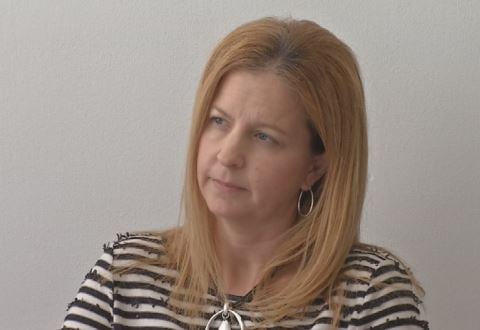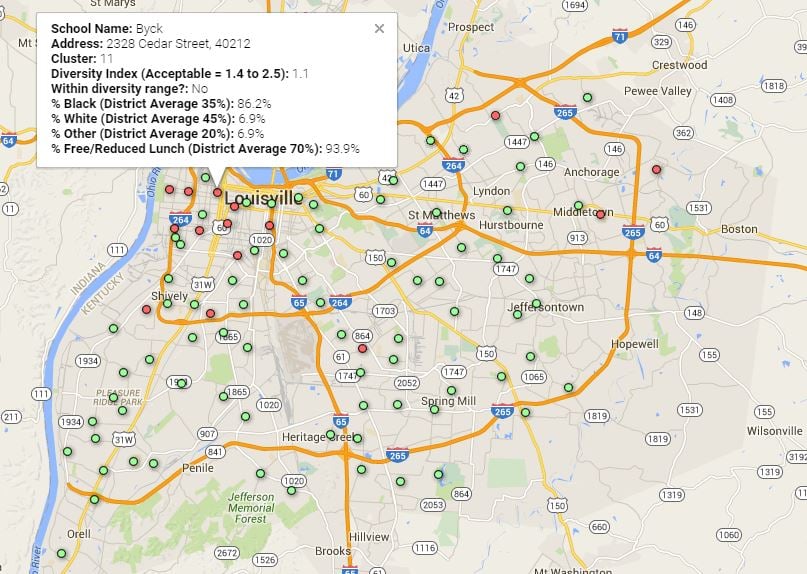Growing up in west Louisville in the 1960s, Vera Langley
doesn’t remember any white students at the old Brandeis Elementary on S.
26th Street, where she went to school.
“Everyone looked just like
me,” said Langley, who is black and lives in the Russell neighborhood.
“…At the time, that’s just the way it was.”
What disappoints
Langley is that the west Louisville elementary schools her
granddaughters attend today -- Roosevelt-Perry and Byck – don’t seem
much different.

“I would have never thought that all these years
later, their classrooms would look just like mine did,” she said.
“Diversity in schools is important. I would like for them to attend a
school with children who come from all sorts of backgrounds. I just
don’t see that at either of their schools.”
For four decades,
Jefferson County Public Schools has prided itself – and earned a
national reputation – for racially integrated public schools, even in
the face of the historic 2007 U.S. Supreme Court decision forbidding the
district from using race as the only factor in assigning students to
schools.
But as the district’s student assignment plan has evolved
over the last few years, a small but growing number of schools are
slipping back into stark racial divisions, according to JCPS statistics
reviewed by WDRB News.
The data shows that while JCPS’ total
percentage of African-American elementary students has declined from 37
percent to 35 percent since the latest student assignment plan was
implemented in 2012, black students have nonetheless become
significantly more concentrated in a handful of mostly west Louisville
elementary schools.
For example, no elementary school had a student body more than 77 percent African American during the 2011-12 year.
But
now, five of the district’s elementary schools – Byck, Foster,
Roosevelt-Perry, Wheatley and Maupin – are over 80 percent black.
 |
| Linda
Duncan |
At
Byck, in the Russell neighborhood, black students account for 86
percent of the student body today, up from 64 percent in 2011-12. About a
mile away at Roosevelt-Perry, the proportion of black students rose
from 57 percent to 79 percent during the same time period.
They
are among 10 elementary schools in JCPS where the proportion of black
students has jumped at least 10 percentage points over the past four
years.
That data – coupled with the fact that those same schools
are also among the lowest-performing in the district, is a growing
concern among some parents, school board members and the NAACP.
“We
keep talking about equity, but how are you ever going to have equity if
your school assignment is inequitable to begin with?” said Linda
Duncan, who has represented south Louisville on the Jefferson County
Board of Education since 2006.
JCPS last overhauled its student
assignment plan – including changing the way it defines diversity -- for
the 2012-13 academic year.
 |
| Raoul Cunningham, president of the Louisville NAACP |
But it was a more controversial move
that took effect the following year – to go from six broad clusters of
elementary schools to 13, each a smaller geographic area – that
community leaders like Raoul Cunningham primarily blame for the
increasing black concentration at some schools.
“Does it concern
us? Of course it does,” said Cunningham, president of the Louisville
chapter of the NAACP. “I don’t think now would be the appropriate time
(to say), ‘I told you so,’ but that is a fact…We were fearful that those
changes would produce today’s results.”
Duncan, who along with
board member Diane Porter voted against increasing the elementary
clusters from six to 13 in 2012, said she agrees.
“I don't think
the intent of our (assignment) plan was to have concentrations of any
particular groups in certain buildings, but that's exactly what we've
evolved into,” she said.
Desire to shorten bus rides
The
district’s elementary clusters are groups of five to eight schools
within a geographic area. Parents usually have the option to send their
children to any of the schools in their cluster, even if it’s not the
school closest to their home. They can also apply for competitive
admission to magnet schools.
The two most recent changes to the
assignment plan – both of which the JCPS school board approved in early
2012 – grew out of desire to shorten the district’s bus rides and to
recognize pockets of racial and socioeconomic diversity throughout
Jefferson County that were undercounted in the previous plan.
“In
the elementary schools, I think there is no question the way the
clusters were redone has had the desired effect of reducing time on
buses – and has created some concentrations of race and poverty,” said
school board chairman David Jones Jr., who was not on the board when the
changes were approved.
Given the “residential segregation of our
county,” Jones said, JCPS’ student assignment plan still results in a
“significantly more diverse school system than we otherwise would have.”
But
by JCPS’ own yardstick – which considers not only students’ race but
socioeconomic factors – a growing number of schools are not considered
integrated.
Fifteen of the district’s 91 elementary schools now
fall outside of the district’s acceptable range of diversity – up from 7
when the plan started in 2012-13, according to district data.
When
assigning students to schools, JCPS does not consider the race,
household income or parental education of any individual student.
Instead,
the county’s more than 500 U.S. Census blocks are grouped into three
categories based on a combination of those factors, and schools are
supposed to have an appropriate mix of students from the three
categories.
In 12 of the 15 elementary schools where the student
body is not sufficiently diverse, too many of the kids come from
disadvantaged areas with higher non-white populations, lower adult
educational attainment and lower household income, according to the
district’s data.
INTERACTIVE MAP
But
three schools in Louisville’s eastern suburbs – Norton, Stopher and
Hite – have the opposite issue: too many students from higher-income,
predominantly white areas with higher educational attainment.
Of those, only Stopher – near the Lake Forest subdivision – was not sufficiently diverse when the new plan began.
In
only four years, the percentage of black students at Hite has dropped
by half – to 12 percent – while Norton’s black population has dwindled
from 22 percent to 9 percent, according to district data.
District not 'hell-bent toward resegregation'
UCLA
professor Gary Orfield, the school integration expert whom JCPS hired
in 2011 to help design its current plan, said in an interview with WDRB
last week that it’s not desirable for the district’s black students to
be concentrated in handful of schools.
“They certainly aren’t what I would want to see,” he said.
But
Orfield said schools like Byck, Maupin and Wheatley – and on other end
of the spectrum, Norton, Stopher and Hite – are “the extremes” and
reflective of “exactly the places (within Louisville) that have been
regional challenges all along.”
Orfield cautioned that JCPS is
nowhere near the “massive resegregation” that urban schools districts in
cities like Cincinnati, Chicago, Indianapolis and Buffalo have
experienced.
“To look the problem in a neighborhood or a sector of
your district and reach the conclusion that you are going hell-bent
toward resegregation” would be incorrect, Orfield said.
But two years ago, former JCPS Superintendent Sheldon Berman warned in
an article for School Administrator,
a trade publication, that the school board’s 2012 changes would
“gradually resegregate the district” and concentrate poverty in certain
schools.
Berman, a staunch defender of the district’s previous
diversity plan, lost his job in 2011 following a disastrous start to the
2010-11 school year with hundreds of students spending extra hours on
buses – some not getting home until 9 p.m. – on the first day of school.
That
event prompted the school board to hire Orfield to redesign the plan –
with the main of goal of reducing bus times while maintaining parents’
ability to choose schools and school diversity.
“There were
several outcomes we were trying to maximize simultaneously, and as you
know, it made it very, very complicated,” Orfield said.
The main
reason it’s difficult to prevent west Louisville schools from becoming
heavily concentrated with black students, he said, is the Supreme
Court’s 2007 decision forbidding school districts from using race as a
direct determinant in assigning students to schools.
That means JCPS is left with “limited tools” that can’t guarantee racial diversity in every school.
Even
under the 2008 plan, which also used socioeconomic factors, 40 percent
of the district’s elementary schools did not meet the diversity
standards, according to Orfield’s 2011 report.

“The basic problem
with any plan that doesn’t consider race directly as a decision criteria
is that it is not going to be as effective as one that does,” Orfield
said.
Orfield noted that while some schools in JCPS are
increasingly concentrated with black students, “We are not seeing a
pattern of extreme white schools emerging.”
That’s an indication
that there are still “quite a significant presence” of minority students
in the district’s high-achieving elementary schools, he said.
At
Hite Elementary, for example, the big drop in black students over the
last four years corresponded with a rise in non-white students such as
Hispanics and Asians, who now make up 16 percent of the student body.
But
for parents like Langley, the fact that her granddaughters' schools
lack diversity and are among the lowest performing in the state is a
huge concern.
At Roosevelt-Perry, only 9 percent of students are
reading on grade level and 12 percent are on grade level in math; at
Byck, 26 percent of students are reading on grade level and 25 percent
are on grade level in math. Both are well below the district and state's
averages for in both subject areas.
Two years ago, Langley says
she tried to get her granddaughters into Lowe Elementary – a higher
performing school located near Oxmoor Mall where 74 percent of students
are proficient in reading and 72 percent are proficient in math.
“Neither of them got in,” she said. “And each year, the test scores at both of their schools have gotten worse.”
JCPS: Diversity only one factor
 |
Dena Dossett, JCPS chief of data mgmt, planning and evaluation
|
Asked
whether schools that don’t meet the district’s diversity goals are a
concern, senior JCPS administrator Dena Dossett said diversity is only
one of the district’s six “guiding principles” in assigning students.
“We
are concerned when schools fall outside of the diversity guideline and
to the extent that we can promote that diversity guideline and place
students so that schools fall within that guideline, we try to do that,”
she said.
But ensuring diversity in schools often conflicts with other priorities, like accommodating parents’ choices, Dossett noted.
“In
order to balance and to have schools fall within that diversity
guideline, what that would mean is that we might have to limit choice,
and it might impact our space within a school,” she said.
Jones,
the JCPS board chairman, noted that seats in the district’s magnet and
high-performing cluster schools “fill up fast,” and one of the board’s
priorities is to make it easier for kids from disadvantaged families to
take advantage of their options in choosing a school.
“That means
choice for kids whose parents don’t speak English or kids whose parents
who work inflexible or unpredictable hours,” he said.
Dossett noted that district figures show 90 percent of JCPS parents are satisfied with their child’s school.
In addition, 85 percent of students get their first choice when picking from schools within their cluster.
When
it came time for her daughter Marissa to go to elementary school,
Andrea Russell chose to send her to Byck, even though the west
Louisville school is a good 20 minutes from her home near Iroquois Park.
“I
really like Byck, and I like what the staff has done with the children,
and I think my child has grown,” said Russell, who is also on the
school's site-based decision making council.
But Russell, who is
black, acknowledges that her loyalty to Byck has meant compromising on
racial diversity, which she feels will become more important for Marissa
when she gets older.
“I don’t feel like she even thinks, ‘Oh, I’m
around a bunch of people that look just like me,’” Russell said. “I
don’t hear her say that.”
Porter: Data will restart conversations
Nine
of the 15 schools that are out of compliance with the district's
diversity guidelines are in school board member Diane Porter’s west
Louisville district – in each case, because the school’s population
includes too many students from disadvantaged areas.
In an
interview, Porter said she disagreed at the time with school board’s
decision to move the smaller geographic clusters, saying the change was
rushed.
But she said the growing concentration of black students in her area’s schools has not been an issue with her constituents.
“Now
the question becomes, what are the next steps for the board as we look
at the current cluster arrangement – what conversations do we need to
have about it?” she said. “The first thing we need to do is put the data
out on the table.”
Orfield said the school board could look at
redoing the geographic clusters once again, but that would be “very
complicated and politically difficult.”
For the west Louisville
schools are that increasingly concentrated with black students, Orfield
said the key is to entice more students from other areas to choose those
schools.
“This is a case where trying to make these particular
schools more attractive and magnetic is one of the only tools the school
district has,” he said.
“The basic problem with any plan that doesn’t consider race directly as a decision criteria is that it is not going to be as effective as one that does,” Orfield said.





No comments:
Post a Comment